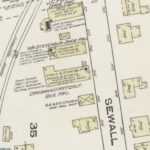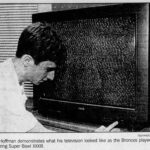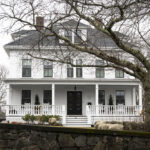Old Photos: Live Photos 11/28/22
Marblehead was made for walking– or, Marblehead made shoes that were made for walking. While its neighbor to the southwest might claim the shoemaking history more loudly, Marblehead’s cobblering history has left its own footprint.
Shoemaking on the North Shore goes back all the way to the Mayflower, when cordwainers, shoemakers trained in crafting new shoes from leather, came to the colonies. Some Marbleheaders learned the craft from these cordwainers, and thus the Marblehead shoemaking industry was born.
The first shoe-shops were small cottages called “ten-footers.” While some fishermen waited for their next trips out to sea, they would handcraft shoes in these small, shed-like structures. Several of these “ten-footers” stand today, like the one on Orne Street in Fountain Park.
Eventually, the shoe shacks were replaced by factories. Around the early 1830s, one entrepreneur cropped up, Joseph R. Bassett, who built a factory near the old Marblehead train to Salem. In 1844, he introduced the sewing machine to the town, shoe production became even more efficient.
Rather than having to hand-sew every piece together, sewing machines helped sew the uppers (the part that covers your foot) to the sole. The first person to use a sewing machine for shoemaking in Marblehead, according to History and Traditions of Marblehead, was a woman named Hannah Johnson, who worked in Bassett’s factory.
Another such shoe factory was that of Joseph Harris & Sons, founded by Joseph Harris, born in 1795. In 1841, he “entered heartily and with the utmost sympathy,” into the shoemaking business, and by the end of his life, amassed a substantial amount of wealth. Harris’ first shoe factory was on Pleasant Street and would go on to build the one of the largest shoe factories in Marblehead. Was, sadly, is the operative word in that sentence.
On Feb. 5, 1867, a fire broke out in the factory and spread to at least two other buildings. The fire was extinguished before even more buildings caught, but the damage done to the factory was irreparable. Harris would move to make a second factory on Elm Street.
The second factory was an Italianate Revival building, indicated by the flat mansard roof, square shape, and quoining and common in the mid- to late-1800s. As seen in the photographs, the factory had many six-over-six sash windows, with some decorated by various types of lintels. It also contained various fire-prevention measures: water supplied by a force pump and tank with a reservoir under the factory and iron pails, likely to be filled with water and thrown on any fires.
According to historical inventory, shoe sole cutting occurred on the first floor of the main building, “cutting and packing” on the second floor, stitching and cutting took place on the third, and bottoming shoes happened on the fourth floor.
In another factory building, finishing was on the first floor and “lasting” on the second. These buildings made up the largest factory in Marblehead.
Surely if such a large factory existed in Marblehead, we all would have noticed, right? Unfortunately, despite all the fire prevention measures, the second factory would fall victim to conflagration. Records show that the company worked out of the second set of buildings until 1890, but in 1896, the main building burned down.
Through the turn of the century, the property was split up and sold, with the only remaining structure being the subject house at 143 Elm St., now a duplex.
Taking a step back, the story of the shoemaking industry in Marblehead is one of resilience. Shoemakers were often undereducated laborers, but they kept up with the times and discourse by reading or listening to someone else read them the news and all sorts of books.
This was an industry in which many women participated, though under difficult circumstances and with less pay. Or look at Harris, who built a massive factory – twice! Perhaps we could learn a thing or two from the determination of Marbleheaders past.




